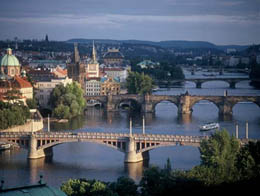
The regulations in Prague govern the height of buildings and prefer infill development
 |
"The current regulations are outdated and tied to the previous regime, which addressed urban development through mass housing construction and completely neglected urban planning," claims the architect. "It's sad that we are having such a debate 25 years after the revolution, but at least this topic has finally been opened," he said. According to him, the building regulations return to the traditional concept of the city from the First Republic. They provide clear rules and tools for urban development, such as height regulations and building lines. Thanks to them, a large building like Quadrio on Národní Street could not be erected in the future. According to him, neither should the project called Polar Bear, which the PPF group wants to build at Vítězné náměstí, be accepted.
According to the new regulations, construction will concentrate on so-called brownfields, underutilized areas in the city center that are well served by public transportation. This includes areas around Prague's train stations, such as Smíchov and Bubny. At the same time, they protect the city's green spaces. "For example, the entire Divoká Šárka is currently a buildable area, which the regulations will allow to change," he explains. Builders will now be required to plant tree-lined avenues on boulevards that are 12 meters wide or more. Outdoor advertising operators have recently expressed discontent that billboards in the city will not be allowed to exceed six square meters in size.
The building regulations have been chosen as one of the electoral topics by representatives from the ČSSD party. At the Thursday meeting of the city council, which is the last in this electoral term, they will propose postponing the effectiveness of the regulations until 2026. The head of the council's control committee, Petr Dolínek (ČSSD), claims that the transition is sudden, and applicants, building authorities, and city hall are not prepared for it. He suggests that it should be subject to council approval. However, the magistrate argues that this is not possible under the law. The council has the exclusive obligation to approve the regulations.
Selected points from Prague's building regulations:
- They want the city to be urban, meaning one that has a generally urban character and offers an adequate amount of services and facilities, compact, meaning one that uses its land well and does not unnecessarily develop open countryside, and green, meaning one that provides enough public gardens and parks and protects and develops open countryside.
- They recommend equipping buildings with bike parking spaces; if this does not happen, the builder must adequately explain the reason.
- They abolish requirements for sunlight in residential rooms in apartments and family houses, which often negatively affect the quality of development. The extent of sunlight infiltration into the apartment should be a personal choice.
- They prescribe prioritizing surface crossings of pedestrian or cycling routes with vehicle routes over underpasses and overpasses.
- They focus on the easy accessibility of areas, such as allowing free passage along local watercourses.
- They return to the concepts of building line, construction line, and regulated building height, which determine the basic parameters for assessing construction. A complete 3D model of Prague will serve for assessing height levels.
- They have a vision of a compact city with short distances and low transport and infrastructure demands. They advocate for the development of vacant lots and brownfields.
- They set the calculation of the number of parking spaces so that it does not burden the surroundings with excessive traffic.
- They require the grouping of lighting poles and tram wires, traffic signs, and street furniture to minimize the restriction of pedestrian movement on sidewalks.
- They prefer solutions that incorporate bicycle traffic as part of the roadway profile. For roads with higher traffic intensity, they allow the separation of cycling traffic.
- They limit the placement of sound barriers (and embankments) in buildable areas, except for placement along fast local roads and railways.
- For newly established streets wider than 12 meters, they introduce the obligation to leave free space for planting tree-lined avenues.
- They reduce the size of standalone advertising devices from the original 12 m² to 6 m².
The English translation is powered by AI tool. Switch to Czech to view the original text source.
4 comments
add comment
Subject
Author
Date
oslunění
PD
14.09.14 09:25
Stavební předpisy x regulační plány
Tomáš Vích
15.09.14 07:12
oslunění
trala
15.09.14 11:10
Předpisy
xyz
16.09.14 03:45
show all comments
Related articles
6
26.03.2018 | Developers: Prague needs new high-rise buildings
0
24.08.2017 | Pirates: Prague must address the development of brownfields and municipal housing
0
16.09.2014 | Regulation of advertising continues to evoke emotions, the city council addressed it again
0
12.02.2014 | Prague is preparing a new regulation on building codes






